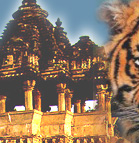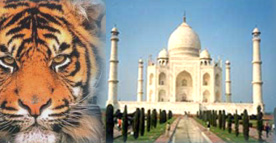|
The Golden temple in Amritsar, Punjab, is the most important pilgrimage for the Sikhs all over the world. The supreme governing body of the Sikh religion which developed in India in the 16th � 17th centuries is also located in the golden temple complex. It is one of the most important religious sites in India, and an indispensible part of tourism in Punjab. One of the wonders of India, the Golden temple is visited by numerous tourists from all parts of the globe including people from all religions and not only Sikhs.
The magnificent temple was built between 1589 and 1601. The foundation of the temple was laid by Guru (spiritual head) Arjan Dev in 1588. Another version states that the foundation stone was laid was a Muslim saint named Miyan Mir. The idea was to build a center of Sikhism, much like Varanasi for the Hindus, and Mecca for Islam. The surrounding village of Ramdaspur came up as his followers started residing there. Ramdaspur came to be known as Amritsar, after the sacred tank called Amrit Sarovar was dug in the area, planned by Guru Amar Das.
The golden temple was rebuilt under Maharaja Ranjit Singh, the great Sikh ruler of the 18th -19th centuries, after being severely damaged by Ahmad Shah Abdali, the Afghan invader who defeated the Marathas in the third battle of Panipat. It was Ranjit Singh who got the dome of the temple covered in gold, giving the temple its name. The interior was also decorated lavishly under his patronage.
The style of the temple is a curious blend of Islamic and Hindu architectural patterns prevalent at the period. The chief components of the temple complex are the two structures known as the Akal Takht and the Hari Mandir.
Hari Mandir:
This three storied temple is the holiest site for the Sikhs across the globe. It is also known as Harmandir sahib, and is greatly revered as the Guru Granth sahib, the holy book of the Sikhs is kept here during day. The dome and upper portion of this temple is covered with gold and it is this structure that gives the complex its name. The marble walls of the first floor feature intricate pietra dura decoration reminiscent of the Taj Mahal. The decorative plasterwork involving animal and floral motifs also adorn the first floor.
The dome of Hari mandir is shaped like an inverted lotus. It is covered with about 100 kilograms (220 lbs) of gold donated by Maharaja Ranjit Singh in 1830. The lower wall of the temple is made with white marble, another feature from the Taj. The Sheesh Mahal or the hall of mirrors is a typically Hindu feature found in the palaces of Rajasthan. The Sheesh Mahal of the Golden temple is located in the top floor. The Guru Granth Sahib is placed under a jeweled canopy in the hall called the Durbar sahib.
Akal takht:
The Akal takht is the seat of the supreme governing body of the Sikhs. This beautiful structure also houses various articles used by the previous Sikh gurus, including swords and flagstaffs. The holy book is kept here at night.
A 60 meters long causeway with nine gilded lamps on either side leads to the Hari mandir temple from the Akal takht through the gateway called the Darshana deorhi.
The most conspicuous feature of the complex, apart from Hari mandir, is the large tank, the Amrit Sarovar. This is where the Sikhs are baptized.
The other major features of the golden temple complex include the common dining hall (guru ka langar), the Assembly Hall, Arjan Dev�s Tree, Dukh Bhanjani Ber, and Gobind Singh�s Shrine.
Learn more about the Golden temple and other temples and tourist places of India in touristplacesinindia.com.
 |
Back to Seven Wonders of India
|

